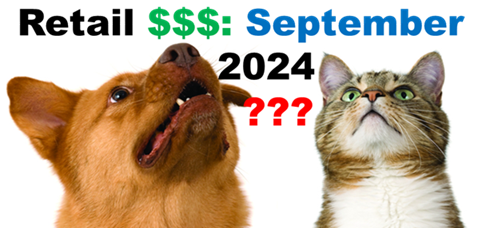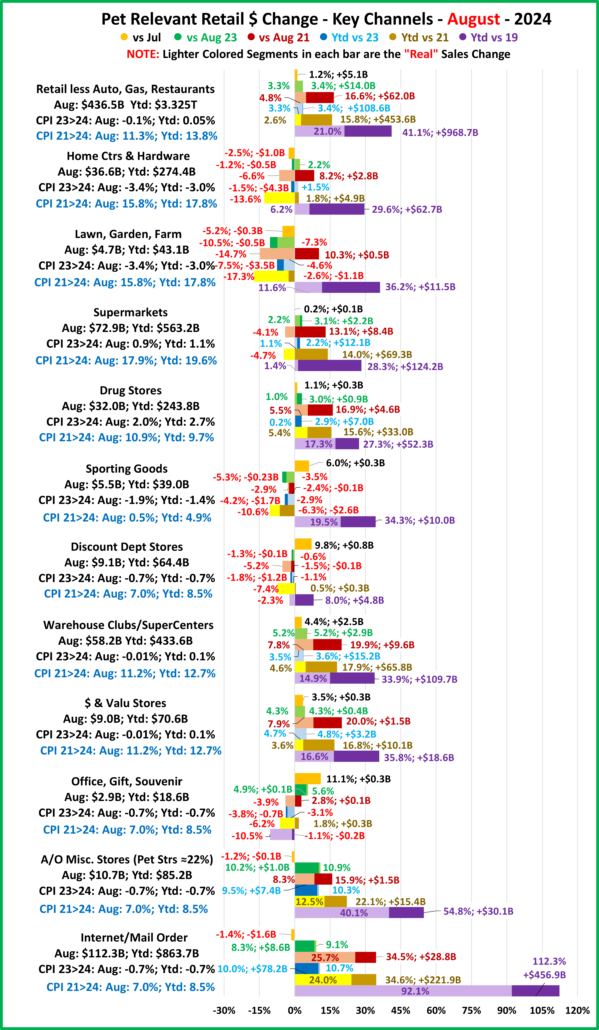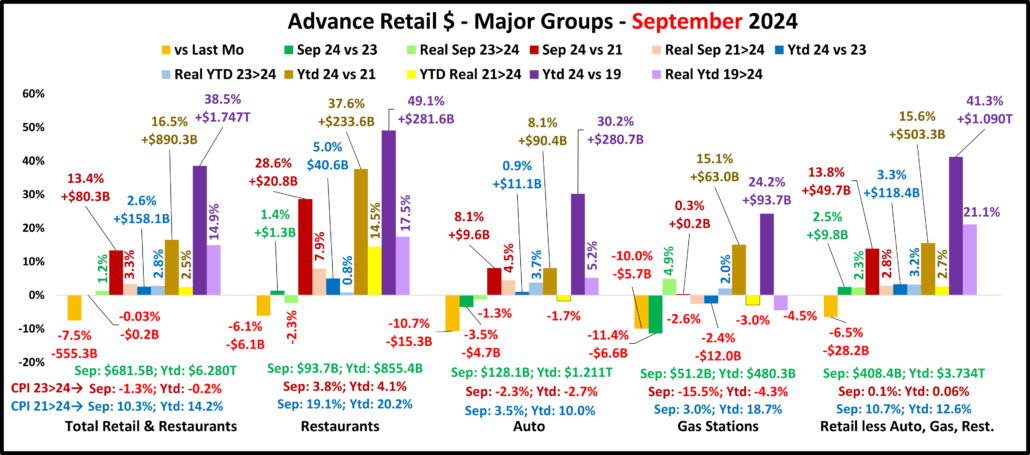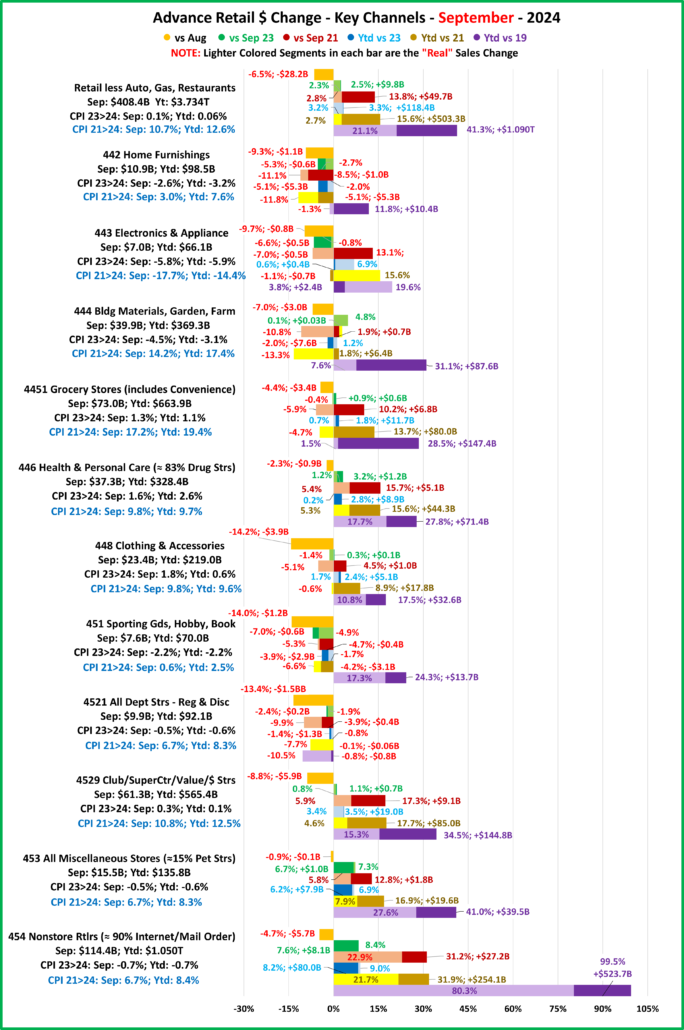Retail Channel $ Update – August Monthly & September Advance
In September, YOY Commodities’ deflation increased to -1.3% from -1.2%. Although still deflating, the high prices from cumulative inflation still impact consumer spending. In September, Total Retail sales were -0.03% vs 23, the 1st September drop since 2009. Relevant Retail was +2.5%, but that was 47% below the average increase. Prices are now deflating in many channels but still high vs 21, which can slow actual $ growth and the amount of product sold. There is still a long road to recovery, so we’ll continue to track the retail market with data from 2 reports provided by the Census Bureau and factor in a targeted CPI.
The Census Bureau Reports are the Monthly and the Advance Retail Sales Reports. Both are derived from sales data gathered from retailers across the U.S. and are published monthly at the same time. The Advance Report has a smaller sample size so it can be published quickly – about 2 weeks after month end. The Monthly Report includes data from all respondents, so it takes longer to compile the data – about 6 weeks. Although the sample size for the Advance report is smaller, the results over the years have proven it to be statistically accurate with the Monthly reports. The biggest difference is that the full sample in the Monthly report allows us to “drill” a little deeper into the retail channels.
We will begin with the August Monthly Report and then go to the September Advance Report. Our focus is comparing to last year but also 2021 & 2019. We’ll show both actual and the “real” change in sales as we factor inflation into the data.
Both reports include the following:
- Total Retail, Restaurants, Auto, Gas Stations and Relevant Retail (removing Restaurants, Auto and Gas)
- Individual Channel Data – This is more detailed in the Monthly reports, and we’ll focus on Pet Relevant Channels.
The data will be presented in detailed charts to facilitate visual comparison between groups/channels. The charts will show 11 separate measurements. To save space they will be displayed in a stacked bar format for the channel charts.
- Current Month change – % & $ vs previous month
- Current Month change – % & $ vs same month last year and vs 2021.
- Current Month Real change vs last year and vs 2021 – % factoring in inflation
- Current Ytd change – % & $ for this year vs last year, 2021 & 2019.
- Current Ytd Real change % for this year vs last year and vs 2021 and 2019
- Monthly & Ytd $ & CPIs for this year vs last year and vs 2021 which are targeted by channel will also be shown. (CPI Details are at the end of the report)
First, the August Monthly. Only Gas Stations were down from July and there were only 2 actual sales drops vs 23 & 21. We should note that Gas Stations are still selling less product than in 2019. Also, Relevant Retail is all positive again. They have been all positive in 7 of the last 10 months and now in 3 of the last 6. ($ are Not Seasonally Adjusted)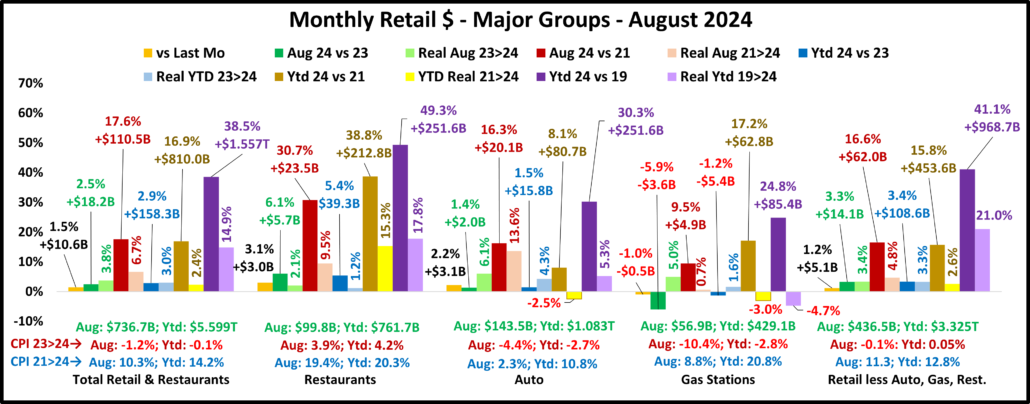
The August Monthly is $0.1B more than the Advance report. Restaurants: +$1.0B; Auto: -$0.8B; Gas Stations: +$0.2B; Relevant Retail: -$0.3B. As expected, $ales were up vs July for all but Gas Stations. A Jul>Aug increase in Total Retail happens about 80% of the time. However, the 1.5% lift was 33% below the 2.1% avg. There were only 2 drops in actual sales – Monthly & Ytd vs 23 for Gas Stations. There were 3 “real” sales drops, down from 5 last month. Total & Relevant Retail and Restaurants were all positive. Restaurants still have the biggest increases vs 21 & 19 but Relevant Retail stayed at the top of “real” performance vs 2019. However, only 51% of their growth is real.
Now, let’s see how some Key Pet Relevant channels did in August in the Stacked Bar Graph Format
Overall– 7 of 11 were up from July. vs Aug 23, 7 were actually and 8 “really” up. Vs Aug 21, 9 were up but only 5 were real increases. Vs 2019, Off/Gift/Souv were actually & really down and Disc Dept Strs were also really down.
- Building Material Stores – The pandemic focus on home has produced sales growth of 30.8% since 2019. Prices for the Bldg/Matl group have inflated 15.8% since 2021 which is having an impact. HomeCtr/Hdwe are only actually up vs Aug 21 and Ytd vs 21 & 19, but Farm stores are only actually up vs Aug 21 & Ytd vs 19. Only the “real” measurements vs 21 are negative for Home/Hdwe. For Farm Stores all “real” numbers but vs 19 are negative. Plus, only 23% of the Building Materials group’s 19>24 lift was real. Avg 19>24 Growth: HomeCtr/Hdwe: 5.3%, Real: 1.2%; Farm: 6.4%, Real: 2.2%
- Food & Drug – Both are truly essential. Except for the pandemic food binge buying, they tend to have smaller changes in $. In terms of inflation, the Grocery rate is only 45% of the rate for Drug/Med products. Drug Stores are positive in all measurements and 63% of their 2019>24 growth is real. Supermarkets’ actual $ are up in all measurements and they are only “really” down vs 2021. However, only 5% of their 19>24 increase is real growth. Avg 19>24 Growth: Supermarkets: +5.1%, Real: +0.3%; Drug Stores: +4.9%, Real: +3.2%.
- Sporting Goods Stores – They also benefited from the pandemic in that consumers turned to self-entertainment, especially sports & outdoor activities. Sales are up from July but their only positives are actual & real Ytd vs 19. Prices are still deflating, -1.9% vs 23. Deflation started in April 23 and is a big change from +1.1% in 22>23 and +7.9% in 21>22. The result is that 57% of their 34.3% lift since 19 is real. Avg 19>24 Growth Rate is: +6.1%; Real: +3.6%.
- Gen Mdse Stores – All actual & real sales were up for Club/SupCtrs & $ stores. On the other hand, Discount Dept Stores were only actually up Ytd vs 21 & 19. All real measurements are negative so none of their growth since 2019 is real. The other channels average 44% in real growth. Avg 19>24 Growth: SupCtr/Club: 6.0%, Real: 2.8%; $/Value Strs: +6.3%, Real: +3.1%; Disc. Dept. Strs: +1.6%, Real: -0.5%.
- Office, Gift & Souvenir Stores – Sales were up 11.1% from July. This set the stage for a better month. They are now only actually down Ytd vs 23 & 19. However, all of their real sales numbers but vs Aug 23 are still negative. Their recovery started late, and their stalled progress may be trying to restart. Avg Growth Rate: -0.2%, Real: -2.2%
- Internet/Mail Order – Sales are -1.4% from July but set a new monthly record of $112.28B. All measurements are positive, but their Ytd growth, +10.0%, is still only 62% of their average since 2019. However, 82.0% of their 112.3% growth since 2019 is real. Avg Growth: +16.2%, Real: +14.0%. As expected, they are by far the growth leader since 2019.
- A/O Miscellaneous – Pet Stores are 22>24% of total $. In May 2020 they began their recovery which reached a record level of $100B for the first time in 2021. In 2022 their sales dipped in January, July, Sept>Nov, rose in December, fell in Jan>Feb 23, grew Mar>May, fell in Jun>Aug, rose in Sep>Nov, fell in Dec>Jan, grew in Feb>May, then fell in Jun>Aug. However, all measurements are positive. They are still in 2nd place, behind the Internet, in the % increase vs 19 and vs 21. Also, 73% of their 54.8% growth since 2019 is real. Average 19>24 Growth: +9.1%, Real: +7.0%.
August had its usual lift as 7 small channels were up vs July. The Total Retail YOY lift was -48% below Avg but 7 of 11 smaller channels and 3 of 4 big groups were up vs Aug 23. Prices are deflating in 9 of 11 channels but cumulative inflation still matters. Many sales lifts are lower as 6 of 11 channels were really down vs Aug 21. The Retail Recovery appears to have restarted. The commodities CPI fell to -1.3% in September. Let’s see if continuing deflation impacts Retail $ales.
Aug>Sep sales were down for all. An Aug>Sep Total Retail drop has happened every year since 1992. However, the -7.5% drop is 21% more than the -6.2% average. All but 4 actual YOY $ measurements are positive for all. 3 of the drops are vs Sep 23 – Gas Stations, Auto & Total Retail. Total Retail was down -0.03% vs 23, the 2nd drop in 24 but 1st September drop since 2009. The Relevant Retail lift vs Sep 23 was -47% below their average. The Restaurants lift was -76% below average. Inflation is a big factor. The CPI for all commodities dropped to -1.3% but is still 10.3% vs 21. There is some “real” retail “not so good” news. In August, 2 measurements were “really” down vs 23 & 21. In September, 5 were really down. Only Relevant Retl was all positive. Of note: from Nov 23>Feb 24 Relevant Retail had 4 straight months of all positive measurements. After 2 months with a negative, they have been all positive in 4 of the last 5 months.
Overall – Inflation Reality – For Total Retail, deflation increased to -1.3% but YOY sales dropped vs Sep 23. For Restaurants, inflation remains high, +3.8% and they are now really down vs Sep 23. Gas prices fell but that group is still in turmoil. Auto prices rose but are still deflating. Sales fell vs Sep 23 and are really down in 2 measurements. Inflation rose from -0.1% to 0.1% for Relevant Retail but sales are again all positive. Their progress continues but is slowing.
Total Retail – Since June 20, every month but April 23 & June & September 24 has set a monthly sales record. In 2023, Sales were on a roller coaster. Up Jul>Aug, down Sept, up Oct>Dec, down Jan 24, up Feb>Mar, down April, up May, down June, up in Jul>Aug, down in September. Prices are now -1.3%, but September YOY sales are down for the 1st time since 2009. Ytd Sales are up 2.6% vs 23, only 39% of their avg 19>24 growth. Plus, only 39% of the 19>24 growth is real. YOY pricing in Total Retail is still deflating but we see its cumulative impact. Growth: 23>24: 2.6%; Avg 19>24: +6.7%, Real: +2.8%.
Restaurants – They were hit hard by the pandemic and didn’t begin recovery until March 2021. However, they have had strong growth since then, exceeding $1T for the 1st time in 2023 and set another monthly sales record in September. They have the biggest Ytd increases vs 23, 21 & 19 but are now really down vs Sep 23. Inflation slowed to 3.8% in September but is still +19.1% vs 21 and +26.9% vs 19. 35.6% of their 49.1% growth since 19 is real and they remain 3rd in performance behind Relevant & Total. Recovery started late but inflation started early. Growth: 5.0%; Avg 19>24:+8.3%, Real: +3.3%. They just account for 13.6% of Total Retail $, but their performance has helped Total Retail.
Auto (Motor Vehicle & Parts Dealers) – They actively worked to overcome the stay-at-home attitude with great deals and a lot of advertising. They finished 2020 up 1% vs 2019 and hit a record $1.48T in 2021 but much of it was due to skyrocketing inflation. In 22, sales got on a rollercoaster. Inflation started to drop mid-year, but it caused 4 down months in actual sales which are the only reported sales negatives by any big group in 21>22. This is bad but their Y/E real 2022 sales numbers were worse, down -8.2% vs 21 and -8.9% vs 19. 2023 was a true rollercoaster but the $ set a new record, $1.595T. $ fell in Jan 24, grew Feb>Mar, fell in Apr, grew in May, fell in June, grew in Jul>Aug, fell in September. Actual & Real $ vs 23 and Real Ytd vs 21 are negative. Only 17.8% of 19>24 growth is real. Growth: 0.9%; Avg 19>24: +5.4%, Real: +1.0%.
Gas Stations – Gas Stations were hit hard by “stay at home”. They started recovery in March 2021 and inflation began. Sales got on a rollercoaster in 2022 but reached a record $583B3. Inflation started to slow in August and prices slightly deflated in Dec 22 & Feb 23, then strongly fell in Mar>Jul to -20.2%. In August they rose to -3.7%. In Sep they were +2.7% but began deflating to -4.2% in Feb 24. In Mar>May they grew, fell in June, rose in July, then fell in Aug>Sep. $ are down monthly & Ytd vs 23. Real sales are down Monthly & Ytd vs 21 and 19. Growth: -2.4%; Avg 19>24: +4.4%, Real: -0.9%. They show the cumulative impact of inflation and demonstrate how deflation can be both a positive and a negative.
Relevant Retail – Less Auto, Gas and Restaurants – They account for ≈60% of Total Retail $ in a variety of channels, so they took many different paths through the pandemic. However, their only down month was April 2020, and they led the way in Total Retail’s recovery. Sales got on a roller coaster in 2022, but all months set new records with December reaching a new all-time high, $481B, and an annual record of $4.81T. In 2023, the roller coaster continued. A December lift set a new monthly record of $494.7B & an annual record of $4.997T. Sales fell in Jan>Feb 24, rose in Mar, fell in Apr, rose in May, fell in June, rose in Jul>Aug, then fell in September, a normal pattern. The September YOY lift of 2.5% is -47% below their 92>23 avg but all measurements are again positive. Also, 51% of their 41.3% 19>24 growth is real – #1 in performance. Growth: 3.3%; Avg 19>24: +7.3%, Real: +3.9%. This is where America shops. They ended 23 and started up 24 strong. In Mar>Apr recovery slowed. In May, things improved, worsened in June, rebounded in July, stabilized in August, then slowed in September.
Inflation is still low, but the cumulative impact is still there. YOY Sales changes are below average and even dropping. The overall progress is slowing. Some changes from August are significant. The Actual drops increased from 2 to 4 and real drops grew from 2 to 5. Gas Stations remain in turmoil and the progress in Auto & Restaurants is slowing. Relevant Retail’s YOY Sales increase slowed but all measurements are positive for the 4th time in the last 5 months. Total Retail broke this pattern in September with a YOY sales drop. After a bad June and the Jul>Aug rebound, the recovery is slowing again in September.
Here’s a more detailed look at September by Key Channels in the Stacked Bar Graph Format
- Relevant Retail: Growth: +3.3%; Avg: +7.3%, Real: +3.9%. All channels were down from August. Vs Sep 23: 7 were up, Real: 5, Vs Sep 21: 7 were up, Real: 5. Vs 19: Only Dept Stores were actually & really down. Furnishing stores were also really down.
- All Department Stores – This group was struggling before the pandemic hit them hard. They began recovery in March 2020. Sales are down -13.4% from August and their actual and real numbers are all negative. They are even actually & really down vs 2019. Growth: -1.4%; Avg 19>24: -0.2%, Real: -2.1%.
- Club/SuprCtr/$- They fueled a big part of the recovery because they focus on value which has broad consumer appeal. $ales are -8.8% from August, but they are positive in all measurements. However, only 44.3% of their 34.5% 19>24 lift is real – inflation’s impact. Ytd growth is below average for the 6th straight month. Growth: 3.5%; Avg: +6.1%, Real: +2.9%.
- Grocery- These stores depend on frequent purchases, so except for the binge buying in 2020, their changes are usually less radical. Actual $ are -4.4% from August, but positive in other comparisons. However, cumulative inflation has hit them hard. Real $ are only up Ytd vs 23 & 19. Only 5% of 19>24 growth is real. Growth: 1.8%; Avg 19>24: +5.2%, Real: +0.3 %.
- Health/Drug Stores – Many stores are essential, but consumers visit less frequently than Grocery stores. $ are -2.3% from August, but they are up in all actual and real comparisons. Because inflation has been relatively low, 64% of their 27.8% growth from 2019 is real. Growth: 2.8%; Avg 19>24: +5.0%, Real: +3.3%
- Clothing and Accessories – Clothes initially mattered less when you stayed home. That changed in March 2021 with strong growth through 2022. Sales are down -14.2% from August, but actual sales are up in all comparisons. However, real sales are only up Ytd vs 23 & 19, but 62% of their 19>24 growth is real. Growth: 2.4%; Avg 19>24: +3.3%, Real:+2.1%
- Home Furnishings – In mid-2020 consumers’ focus turned to their homes and furniture became a priority. Prices are still deflating but they were high in 2022. Sales are -9.3% from August and negative in all measurements but actual vs 2019. They have sold less product in 2024 than in 2019. Growth: -5.1%;Avg 19>24: +2.3%, Real: -0.3%
- Electronic & Appliances – This channel has had many issues. Sales fell in Apr>May of 2020 and didn’t reach 2019 levels until March 21. $ are -9.7% from August and they are only actually positive Ytd vs 23 & 19. Due to strong deflation , real sales are positive for all but vs Sep 23. Note: Their growth is now below their 19>24 average. Growth: +0.6%; Avg 19>24: +0.7%, Real: +3.7%.
- Building Material, Farm & Garden & Hardware –They truly benefited from the consumers’ focus on home. In 2022 the lift slowed as inflation grew to double digits. Prices are still deflating but sales are -7.0% from August. Actual sales are only down Ytd vs 23. Prices are deflating but they are still 14.2% above 21 so real sales vs September & Ytd 21 are negative. Also, just 24% of their 19>24 sales growth is real. Growth: -2.0%; Avg 19>24: +5.6%, Real: +1.5%.
- Sporting Goods, Hobby and Book Stores – Consumers turned their attention to recreation and Sporting Goods stores sales took off. Book & Hobby Stores recovered more slowly. After a big June lift, $ fell -1.5% in July, rebounded +11.5% in August, then fell -14.0% in September. All comparisons, actual & real, but Ytd vs 2019 are negative. Their inflation rate has been lower than most groups so 71% of their 24.6% growth since 2019 is real. Growth: -3.9%; Avg 19>24: +4.4%, Real: +3.2%.
- All Miscellaneous Stores – Pet Stores have been a key part of the strong and growing recovery of this group. They finished 2020 at +0.9% but sales took off in March 21 and have continued to grow. Sales are -0.9% vs August, but positive in all measurements vs 23, 21 & 19. They are still 2nd in the % increase vs 19 and 3rd vs 21. 67.3% of their 41.0% 19>24 growth is real, but their current Ytd lift is still 13% below average. Growth: +6.2%; Avg 19>24: +7.1%, Real: 5.0%.
- NonStore Retailers – 90% of their $ comes from Internet/Mail Order/TV. The pandemic accelerated online spending. They ended 2020 +21.4%. The growth continued in 2021 as sales exceeded $100B for the 1st time and they broke the $1 Trillion barrier. Their $ are -4.7% from August but their YOY lift grew to +8.4% in September. However, their Ytd lift is still 45% below average. They are positive in all measurements and 81% of their 99.5% 19>24 growth is real. Growth: 8.2%; Avg: +14.8%, Real: +12.5%.
Note: Almost without exception, online sales by brick ‘n mortar retailers are recorded with their regular store sales.
Recap – The Retail recovery from the pandemic was largely driven by Relevant Retail and by the end of 2021 it had become very widespread. In 2022, there was a new challenge, the worst inflation in 40 years. Overall, inflation has slowed considerably from its June 22 peak and now 7 channels are deflating. This should help the Retail Situation. As expected, $ fell from August but the -6.5% drop for Relevant Retail was 20% more than their 92>23 avg. This was a big drop, but the big problem has been slowing YOY monthly increases. In August, their 3.4% lift vs 23 was -27% below average, only 3 of 11 channels had a YOY $ decrease and 10 of 11 sold more product. In September, their 2.5% YOY lift was -47% below average, 4 of 11 had a $ decrease and only 5 of 11 sold more product. Also, in August, there were 3 channels with lifts of 6.5+%. In September, only 2. Plus, in August, 1 channel, Electronics/Appliances again had a Ytd lift above their 19>24 Avg. That ended in September. Things are definitely worse, but here is some good news. Relevant Retail is again positive in all comparisons. That has happened in 4 of the last 5 months. The recovery slowed in June, strongly restarted in July, continued in August, but is definitely slowing again!
Finally, here are the details and updated inflation rates for the CPIs used to calculate the impact of inflation on retail groups and channels. This includes special aggregate CPIs created with the instruction and guidance of personnel from the US BLS. I also researched data from the last Economic Census to review the share of sales by product category for the various channels to help in selecting what expenditures to include in specific aggregates. Of course, none of these specially created aggregates are 100% accurate but they are much closer than the overall CPI or available aggregates. The data also includes the CPI changes since 2021 to show cumulative inflation.
Monthly YOY CPI changes of 0.2% or more are highlighted. (Green = lower; Pink = higher)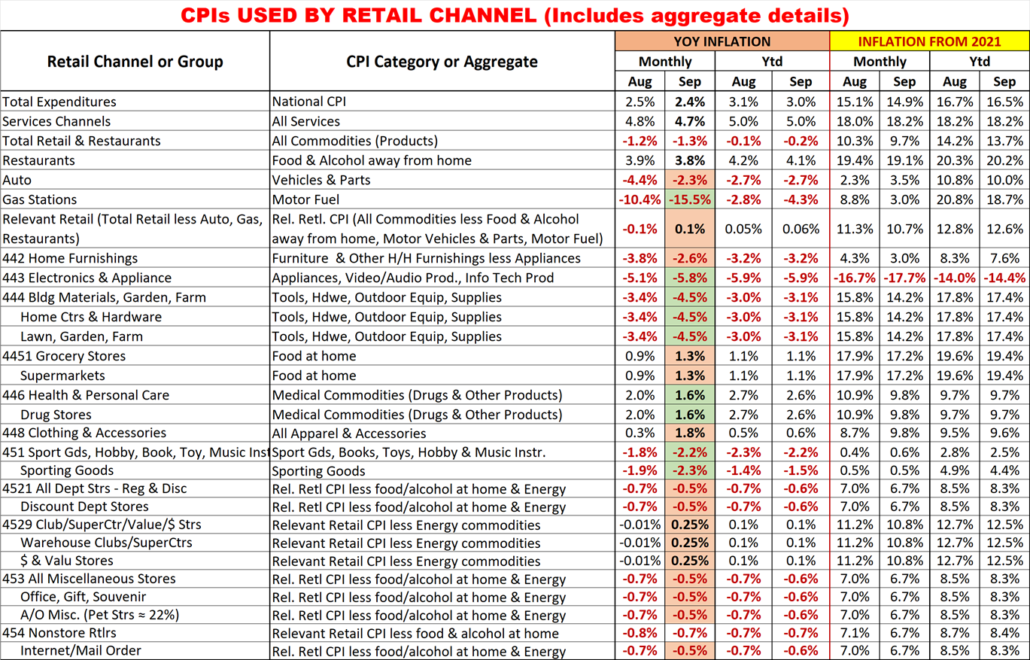
I’m sure that this list raises some questions. Here are some answers to some of the more obvious ones.
- Why is the group for Non-store different from the Internet?
- Non-store is not all internet. It also includes Fuel Oil Dealers, the non-motor fuel Energy Commodity.
- Why is there no Food at home included in Non-store or Internet?
- Online Grocery purchasing is becoming popular but almost all is from companies whose major business is brick ‘n mortar. These online sales are recorded under their primary channel.
- 6 Channels have the same CPI aggregate but represent a variety of business types.
- They also have a wide range of product types. Rather than try to build aggregates of a multitude of small expenditure categories, it seemed better to eliminate the biggest, influential groups that they don’t sell. This method is not perfect, but it is certainly closer than any existing aggregate.
- Why are Grocery and Supermarkets only tied to the Grocery CPI?
- According to the Economic Census, 76% of their sales comes from Grocery products. Grocery Products are the driver. The balance of their sales comes from a collection of a multitude of categories.
- What about Drug/Health Stores only being tied to Medical Commodities.
- An answer similar to the one for Grocery/Supermarkets. However, in this case Medical Commodities account for over 80% of these stores’ total sales.
- Why do SuperCtrs/Clubs and $ Stores have the same CPI?
- While the Big Stores sell much more fresh groceries, Groceries account for ¼ of $ Store sales. Both Channels generally offer most of the same product categories, but the actual product mix is different.

